This 1941 Dodge WC needs no introduction to you, does it? Chances are pretty good that if the truck wasn’t in the photos, you would know exactly where I was at and who I was standing near. For anyone who doesn’t know, this is “Sgt. Rock”, and it’s the culmination of over a decade of Stacey David’s vision and hard work. But that isn’t even the half of what this truck means to the man we watched on television…this truck goes back even further than the day he drug it out of the weeds in Idaho.
First, you have to understand the history of this truck: it was one of the 79,771 trucks made under a War Department contract and is from one of the early half-ton (1940-42) production runs…the downward-sloping nose is the feature that gives this away. It served dutifully in the States and in the European theatre of operations, but at one point had to be sent home for repairs, during which the originally open-topped truck gained a roof, to be come a full cab, before it returned to service.
After the war, there was a flood of surplus vehicles and the WC was one of the trucks that managed to find a new home and a new life. For $100, Friedman Memorial Airport in Hailey, Idaho adopted the Dodge and put it to work as a heavy-duty plow truck in 1955. For years, the WC would be the airport’s workhorse, with it’s plow and tire chains, waiting for the snow. While most people probably didn’t give the old military truck much of a thought in passing, a young Stacey David did. As a kid, whenever the family car passed by the airport, he would be peering out of the window to get a good look at the old yellow truck that didn’t look like anything else on the road. The idea was set: Stacey would have to have a truck like this at some point in his life.
After years of work that saw him evolve into a custom vehicle builder and television personality, the memory of the old Dodge at the airport proved to be too much to ignore and he started nosing around for a suitable truck to build. During a discussion with his father, he learned that there was a potential candidate truck sitting in Belleview, Idaho that might be of interest. Turns out that the old airport plow truck had been sold off, replaced with a brand-new tractor, and had managed to evade the scrapyard. Time hadn’t been kind to the WC…after years of being used and abused, it wasn’t in the greatest condition, but that didn’t matter, considering the plan that Stacey had in store.
Just from the name, it’s immediate that there is still a strong military correlation, and that isn’t by accident. Stacey wanted the Dodge to pay tribute to the military in some way with the former plow truck, and went out of his way to make sure that wasn’t lost in translation. Sure, it’s a massive truck, one with an absolutely beastly big-block Chrysler under the hinged hood, and it sits about as tall as a modern-day LMTV, but you have to look at the details and know certain stories behind why a certain part was chosen, or why something was done the way it was done.
Ever since I first got the opportunity to shoot photos at the Rattletrap Productions studio, the one thing I’ve noted about Stacey is that he is a man of details when it comes to the vehicles. Most of those details tend to get lost when viewing the vehicle overall, but it’s also those little details that make the difference when you look at a vehicle. Many people are quick to jump on the fact that Sgt. Rock has taken a bit over a decade to complete. While other projects have taken time away from finishing the big Dodge, Stacey views the time invested as a necessity: with a vehicle project as in-depth and as ambitious as Sgt. Rock has been, you do not want to cut corners, cheap out, or hurry the work. There is a craftsmanship involved that Stacey holds dear, that he hopes will inspire others as they work in their garages.
Ok, we know that you’re here to see the truck, so let’s get to it. There are tons of details to this truck…you ought to see the entire parts list alone!…but for the sake of brevity, we will touch on some of the more notable modifications:
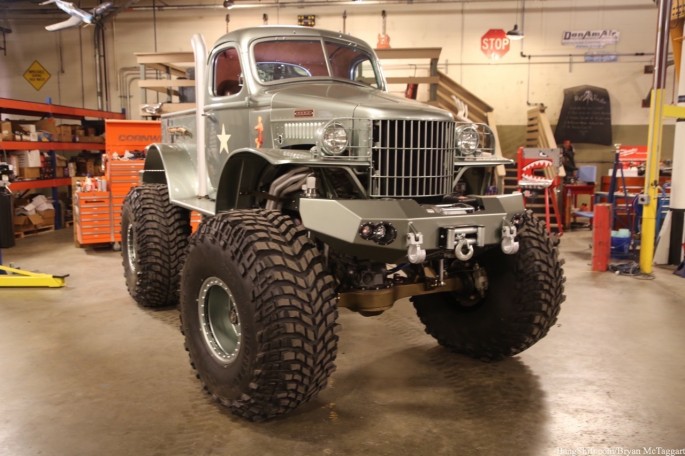
Straight off of the bat: it’s massive. This is the first vehicle I’ve shot pictures of where a ladder of some sort was mandatory. But keep this in mind: it’s street-legal. That’s right, he actually drives this thing around on the roads of Tennessee. You can only imagine the reactions that the Dodge incurs whenever he has to stop and top off the tank. Take note of the front bumper: that is a Fab Fours Toyota FJ front bumper that has been mildly modified to work on the truck and to accept the larger Warn winch.
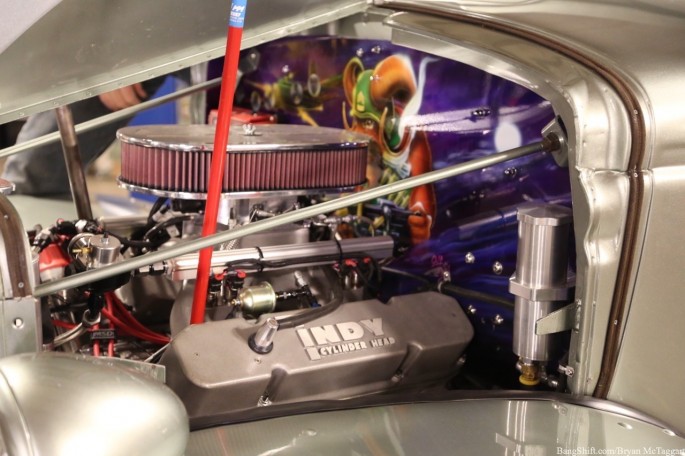
The military, whether you like it or not, has to have an element of violence about it, and Sgt. Rock is no different. Under the hinged hood is a 10.25:1 605 cubic inch all-aluminum big-block Mopar that was built by Indy Cylinder Heads. It’s good for 851 horsepower and 836 ft/lbs of torque, and is fed via a Holley Dominator EFI setup. Jon Kaase Racing tuned the RB mill to it’s full potential. Backing the engine is a Bowler Transmissions-built Chrysler 727. When you have that kind of grunt fighting the weight of that rolling stock, you do not cheap out on the transmission.

The firewall mural of Sgt. Rock, the fighting ram, was painted on by Cliff Daigle, who also painted on the Memphis Belle pin-up girls on the front fenders.
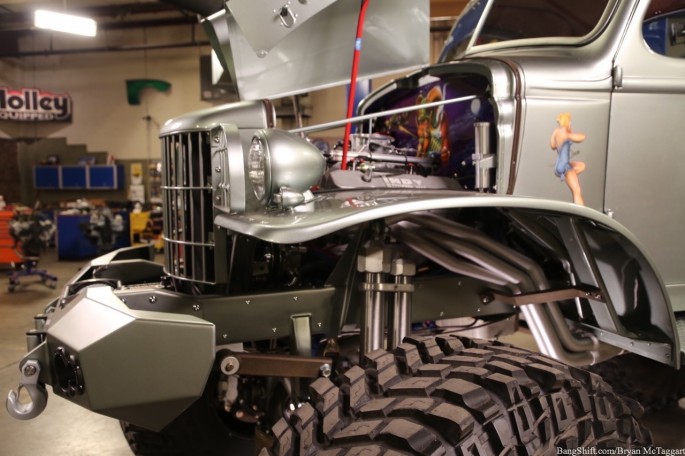
The big Mopar can bark, and makes it’s presence known via stainless steel headers, pipes and stacks courtesy of Stainless Works. Take note to a couple of detail items: the frame bolts are all measured out and separated to form the letter “W” and there are no inner fenders. There used to be at one point, but after feeling like something wasn’t quite right with the look, Stacey removed them and instead made the “strap” that goes around near the collector.
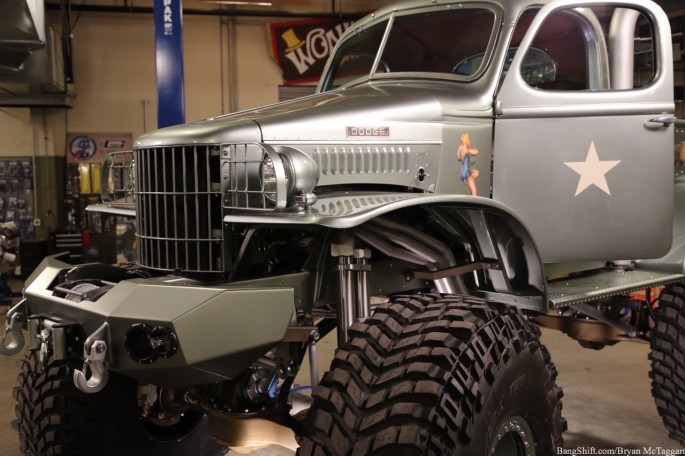
More details you might otherwise miss: Note the bodylines just above the pin-up girl. Notice how they are different? When the WC was given a hard-top, it got one from a 1940 International. Due to the wartime effort, Chevrolet, International, Dodge and Fargo were cranking out trucks as fast as they could be made, and more often than not the cab of one would be grafted onto another. During teardown, Stacey found that the cab had been mated together using lead as a filler with decent work. There has been some massaging here to make the bodyline disparity work…that crease in the hood was put in to continue and terminate the indentation.
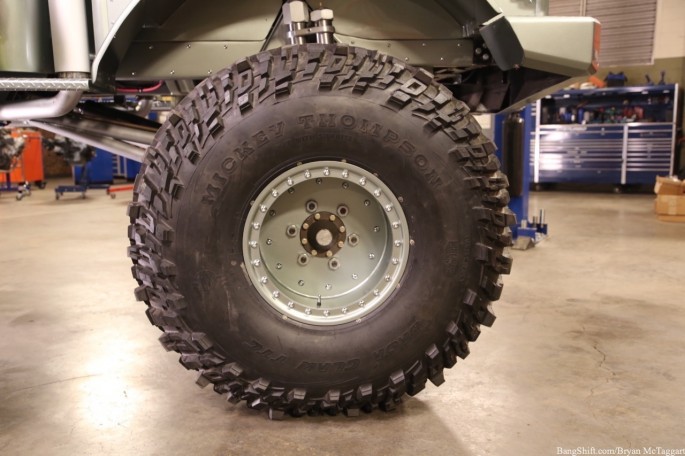
There you go, Mickey Thompson Baja Claw TTC tires, measuring 54×21.20×20, on 20×18 Marsh Racing beadlock wheels. They are DOT approved, and they are easily just as at home running over whatever you want. Don’t ask how heavy they are…just know that running things over and landing after a jump isn’t an issue. Stacey confirmed that both things have happened…which elicited an expletive or two from the author in disbelief. Yes, he’s jumped this beast, and he says that it lands like a pillow.

Inside is form follows function and while by most standards it would be considered “spartan”, really it’s a very nice place to be. A Vintage Air unit keeps temperatures optimal whatever the weather. Contrary to normal, the WC doesn’t feel cramped or small in any way inside. It’s no F-350 King Ranch, but you aren’t cramped in the least. Everything is right were you would expect it to be. You can even swing the windshields up if you so wish!
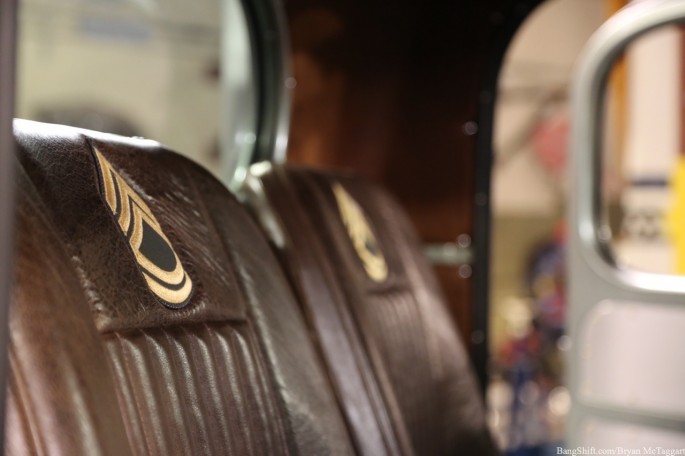
The bomber-jacket leather seats are from Mastercraft Seats. They have a pocket sewn into the outboard sides, and the seats give away Sgt. Rock’s true rank: He’s an Army Sergeant First Class. The seats might look a bit thin, but they are comfortable…and that’s not just Stacey’s words. I approve.
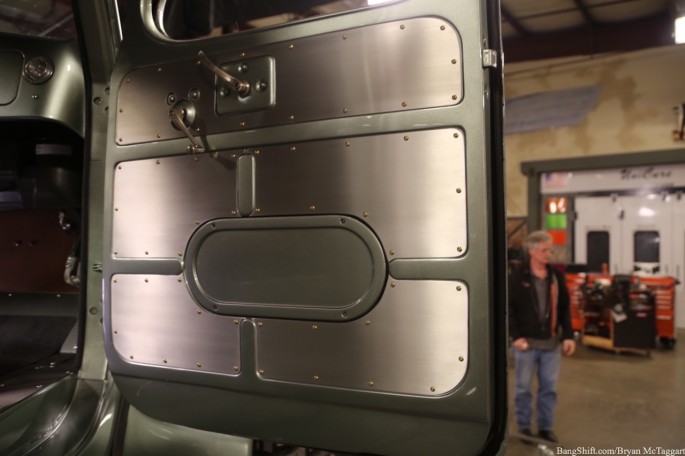
Like everywhere else on the truck, the metalwork and fastener situation is spot-on. Stacey worked with the crew that restored the “Memphis Belle” B-17 and as a result, managed to source a couple of extra bits from the restoration for the Dodge.

Gauges are Classic Industries bomber-style pieces, the steering column is an ididit unit, the steering wheel is a Grant piece, the pedals are from Lokar, the shifter is a TCI unit, and yes, that is a great view. The data plates are from Vintage Power Wagons, including the special plate between the speedometer and tach warning about “special equipment”.
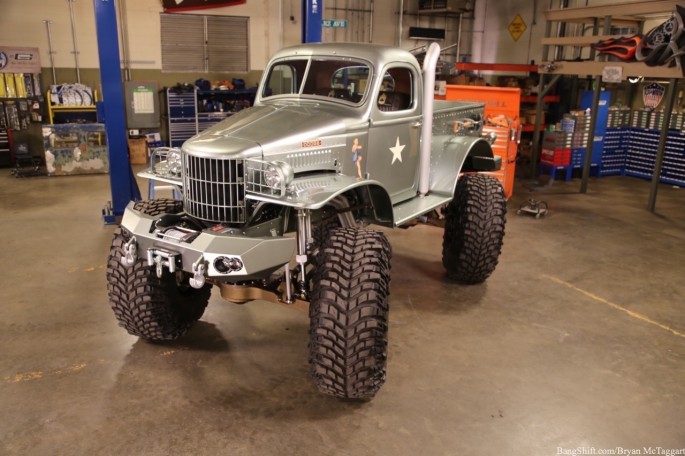
In order to keep Sgt. Rock somewhat manageable when out in public, rear-steer has been equipped. The 2.5 ton Rockwells are steered by Nowak Industries hydraulic rams, the front via the steering wheel and the rear via a lever-type steering system with automatic centering. Brakes are a combination of International discs and calipers from a Ford F-350. The ARB air locker-equipped Rockwells get the power through Carolina Driveline shafts from an Atlas II transfer case.

You’re seeing correctly: twin .50 caliber Browning M2 machine guns, though these two only fire a fuel mixture to make noise and flames…they don’t shoot .50 caliber rounds, no matter how bad traffic gets. The one-off dual .50 mount was built by Mark Woodriff and Dave Marshall, two of the restoration experts that assisted with the restoration of the “Memphis Belle” B-17. The rear mural and the mural on the shovel was done by Mickey Harris, and on the other side, a legitimate fireman’s pick-ax resides in the other tool mount.

So what does it take to put a project vehicle like Sgt. Rock together? It’s taken over ten years (of which, three or four years the project sat idle while other projects took priority), thousands of man-hours, and several trial-and-error moves that added to the totals. Things like frame bolts became sticking points that marked the difference between “done” and “not done”, and until it was good in Stacey’s eyes, the truck simply was not done. Some might call it being picky, but Stacey sees it as the kind of attention to detail that is the difference between slamming parts together and a craftsman.

In addition to his well-known automotive accomplishments, Stacey is also an avid musician, and one of the more unique things that he does is to have a guitar commissioned to go along with each project vehicle that he builds. Tennessee Electric Guitar is the responsible party for the Sgt. Rock guitar, and you can click HERE if you want to learn the technical details.

We want to thank Stacey David for opening up Rattletrap Studios to us (again!) and for giving us time to crawl in, on, around, under and through the sum of years of his work. We also want to thank two members of his staff, Jonathan Kosik and Mark Ramey, who were practically bending over backwards to make sure that everything would be good for the photo shoot.








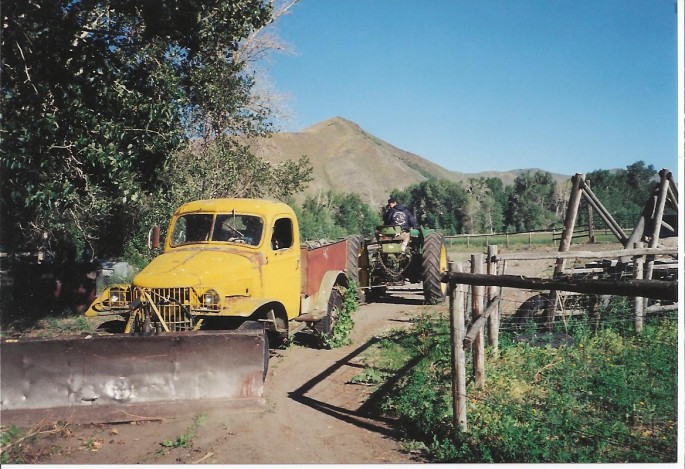





Well done.
Awesome truck but this story needs a video of it running.
I want to see a video of him jumping it.
The fact that he did jump it instead of using it as a showpiece is the best part.
I wonder if he’ll ever mount a plow on it.
Call me if you want to sell this. Very interested to add to my Ram fleet.
Sgt. Rock has been a badass build that I followed for years even when he switched networks.
Awesome truck and a great guy. Met him at SEMA a couple of years ago.Wanted to know “what I was working on” rather than talk about himself. Even asked what kind of projects my son builds with his Legos!
First class guy in the hobby. Always enjoy seeing his work on the program. Hope to meet him some day, maybe as the HRPT ends in Bowling Green KY.
Great PW ,looks awesome .And I have said it before .And I’ll say it again. Mopars Rule
Really dig ALL of Stacey’s builds because none of them are run of the mill builds that everyone else does. Also like how he shows us how/why he designs and builds everything unlike all those other stupid deadline shows that think we give a crap about personalities.
Stacey keep it up and do more shows per year.
Well done , well done , well done . Craftsmanship is impeccable . Concept is outstanding . A fine tribute to our service people . I could never understand rat rods/trucks . where is the craftsmanship ? Great article . Love Stacy David .